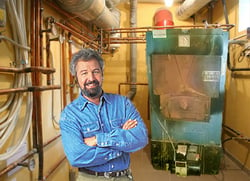I was driving through the quaint streets of the village in my town last weekend and I recognized the long awaited signs of spring. First nature, grass growing, flowers blooming, and increasing hours of daylight. Second people, landscapers raking and mulching, boaters uncovering their crafts, and of course homeowners and carpenters out surveying the winter damage. I am no stranger to these activities; growing up in the Northeast, changing seasons is part of the lifestyle and for me a big draw to this part of the country. As a homeowner, the seasonal maintenance requirements are just part of the ritual. Each year, I assess what needs to be done and then weigh the costs against the need in order to pick the projects to prioritize!
Of course there is the one maintenance task that I take very seriously…keeping my furnace alive and running winter after winter. My furnace is a baby compared to my 100+ year old farmhouse, a mere 40+ years old and the size of a VW Beetle. When it kicks on the whole house shakes. “OMG!” you might say, “why wait till spring to think about it?” Because spring is when I need to decide to replace it or not, and as most homeowners know, the cost of replacing it will be significant. Each season for the first 14 years, I decided I could make it one more year, but when oil priced out over $4 a gallon two winters ago, I was sold…next spring new furnace. Lo and behold, oil prices plummeted and I hung on for another year. However, three emergency visits from the repair man this winter made me realize I had hung on too long.
Luckily, I knew this day was coming, so I planned it in my budget. I scheduled the service and negotiated a discount with my Heat and Oil Company, who is thrilled to have a summer install. Next winter I will be running a highly efficient heating system, lower cost, quiet and clean. I will miss that rumble when it kicks on though!
To me, there is a synergy between running a house and running a business. In particular, it is important for investment managers to recognize when technology solutions are no longer working for them, when work-arounds are no longer viable, and when it may be time for new tools. My experience has taught me that getting in front of the budget process is half the battle.
Traditionally, management requires new and revised budgets and proposals in the fourth quarter for expenditures in the following 1-3 years (5 year planning went out the window years ago). As departmental budgets are reviewed and assessed against each other, it is common for management to approve funding for a limited number of sizeable initiatives. For instance, in recent years, investment firms have focused on organization-wide data governance programs, especially in response to new regulatory and reporting requirements. They have also spent significant resources on developing new and refining existing distribution channels. Programs like these, hot topics in the industry and critical to the future success of an organization, will own the attention of senior management; but what about funding for the ‘role’ specific tools people use every day?
As a portfolio manager, are you equipped with tools to do your job, are your security analyses, characteristics, performance, and market or portfolio risk calculated on inadequate tools with manual work-arounds and Excel calculations? Are you performing portfolio compliance on a best efforts basis because the tools are imperfect or outdated and may not account for some of the portfolio guidelines?
As an operations manager, are your reconciliation items and unconfirmed trades tracked and managed manually? Have you missed the last couple of upgrades on your portfolio accounting system? Are your metrics reliant on maintenance of lists and manual counts?
And what about client service? Are your client reports still a collection of reports and spreadsheets from different sources and in different formats, cobbled together, and tweaked to be cohesive and informative?
Whether it is new investment products, global operating changes, or clients’ increased sophistication and desire for more detailed and timely information, your need for upgraded and/or new technologies may be now. Like my furnace, it is easy to think you can eke by one more season and resist the large expenditure now. If you wait until the ‘system’ breaks, you are in crisis mode or the risk has become critical. For obvious reasons, this is not prudent.
An outside advisor (like a furnace repairman) may be the vehicle your organization needs to help evaluate your situation, priorities, and to assist you in building a case for future funding. A third party can perform a strategic assessment to evaluate your current state of people, process and technology with a level of perspective you may not have in-house. Such an assessment can identify weaknesses in your technology and operational models that you may or may not be aware of, and align your firm with your peers in the industry. You can then use these findings to create a roster of initiatives and projects, develop a roadmap for implementation, and formulate a cost model to aid you in the budget process.
With a fresh start, I think spring is the perfect time to do this type analysis and planning and to lay the groundwork for next years’ budget planning. If you prepare your case now, you’ll reap the rewards when 2017 rolls around.








Comments